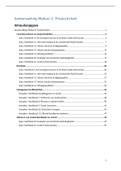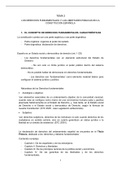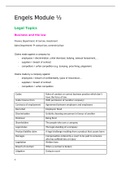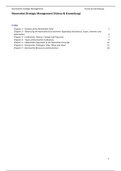baKalat, Carlson, Pinel/Barnes
The nervous system has 2 kinds of cells Neurons and Glia.
Neurons- cells specialized in reception, conduction, and transmission of electrochemical signals.
TYPES OF NEURONS:
Motor neuron –located in the central nervous system and controls the muscles or the secretion of a gland. Efferent
axon – carries info away from the structure (Exit) – every motor neuron is efferent from the nervous system.
Sensory neuron- it is specialized at one end to be highly sensitive to a type of stimulation (like light, sound, touch). It
conducts that information from the skin to the sipinal cord. It sends the info to the central nervous sytem.
afferent axon – bring info into the structures (Admits) – every sensory neuron is afferent to the rest of the nervous
system
Interneuron/
intrinsic neuron
– neuron located
totally in the central
nervous system.
With a short axon or no
axon. Their function is
to integrate neutral
activity within a single brain structure. association neurons: impulse moves between sensory and motor
neurons, mostly multipolar.
Classification according to structure:
1. multipolar neuron – most common type in the central nervous system. It’s a neuron with
one axon and many dendrites attached to its soma.
2. Bipolar neuron – one end of the soma has an axon and the other has a dendrite.
3. Unipolar neuron – a neuron with one axon attached to its soma. The axon divides: one
branch receives sensory info and the other sending info to the CNS
In the CNS bundles of axons are called tracts and in the PNS these bundles are called nerve bundles.
STRUCTURE OF THE NEURON:
All neurons have a soma (cell body), dendrites, axon, and presynaptic terminals.
Dendrites – branching fibers that get narrower near their ends. The surface has presynaptic receptors,
where the dendrite receives info from other neurons. The greater the surface of the dendrite the more
info it can receive.
o Dendritic spines – short outgrowths that increase the surface area for synapses.
Cell body/ soma – contains the nucleus, ribosomes, and mitochondria. Where most of the metabolic
work happens. In many neurons the soma is also covered with synapses.
Axon – thin fibber of constant diameter. It conveys an impulse towards other neurons, organs, or
muscles. (The length can be very big). The axon can have branches
o Vertebrate axons are covered with myelin sheath with interruptions called Ranvier’s nodes –
they speed up the carrying of info
o Invertebrate axons don’t have it.
Presynaptic terminal/terminal buttons – The end of each branch of the axon, that is a swelling. Here the
axon releases chemicals that cross through the junction between the neuron and another cell.
,Synapse – a junction between the terminal button of an axon and the members of another neuron.
INTERNAL STRUCTURE OF THE NEURON
-Membrane – defines the boundary of the cell.
It is a double layer of lipid molecules.
- Nucleus – structure in the centre region of
the cell, contains nucleolus (produces
ribosomes) and chromosomes (a strand of
DNA, with associated proteins translated from
mRNA)
- Cytoplasm – viscous semiliquid substance in
the interior of the cell.
- mitochondrion – an organelle that is
responsible for extracting energy from the
nutrients.
- ribosomes – internal cellular structures on
which proteins are synthesized.
Synaptic vesicles – spherical membrane
packages that store neurotransmitter
molecules ready for release near synapses.
- Neurotransmitters – molecules that
are released from activity of other
cells.
Glia cells – supporting neurons of the nervous system. there are the same number of neurons and glia in the nervous
system.
Terminology to describe the nervous system:
NERVOUS SYSTEM – basic features
CONSTITUTION OF THE NERVOUS SYSTEM
Central nervous system (CNS) – the brain and the
spinal cord.
Peripheral nervous sytem (PNS) – outside the brain
and spinal cord, including nerves attched to the brain
and spinal cord. Devidded in two:
o Somatic Nervous System –
involved in communication with
the external world
Afferent nerves – axons from muscles,
joints, eyes (…), into CNS
Efferent nerves – from CNS into skeletal
muscles
o Autonomic Nervous System (ANS) –
involved in the unconscious processes.
Regulates the body’s interna
environment. Regulates the smooth
muscle (like hair follicles), cardiac
muscle and glands. It is divided by two,
with some exceptions, organs are
intervened by the two.
Afferent nerves (away) – takes sensory
info from organs into CNS
Efferent nerves – take motor info from
CNS into organs
a. Sympathetic nervous system– controls functions that
accompany arousal and more energy – ex: speeds the heart rate. Sympathetic Nerves – autonomic
motor nerves that project from the CNS, located in the lumbar (small back) and thoracic (chest area).
,b. Parasympathetic nervous system – controls functions that are involved with increasing the body’s
supply of sorted energy – ex: slows down the heart rate. Parasympathetic Nerves – autonomic motor
nerves that project from the brain and sacral (lower back) region of the spinal cord.
Protection of the Nervous System
The entire nervous system is covered in meninges – a
connective protective tissue of 3 layers:
Dura matter
Arachnoid membranes (spiders web)
Subarachnoid space – contains large blood
vessels and cerebrospinal fluid.
Pia matter – delicate inner meninx that
attaches to the nervous system
The PNS is covered in 2 layers of meninges
- dura mater and pia mater.
Grey matter – is composed largely of cell bodies and unmyelinated interneurons
White matter – composed by largely of myelinated (fat that lets the information travel faster) axons
The cerebral ventricles are the 4 large internal chambers of the brain, they are interconnected by a series of
openings and from a single reservoir. They let the CSF pass, which is important, so the brain doesn’t feel anything
when the head moves.
The Blood Brain Barrier -Mechanism that impedes the passage of many toxic substances from the blood into the
brain.
Passive transport – smaller molecules that get through – oxygen, water, drugs
Active transport – route where large useful molecules are actively transported through blood vessel walls. -
glucose
Central Nervous System
Devolpment of the brain: during the embryonic development of neurons system, there is a fluid-filled
tube(neural tube) that will eventually devolp into the brain. First there are 3 swellings at the top of this
tube which devolp into the forebrain, the midbrain and the hindbrain. The tube is still present in the adult
brain as a central canala and as ventricles.
Brain: 3 major divisions of the brain (forebrain, midbrain, and hindbrain)
The Forebrain
the most rostral of the divisions of the brain. Consist of the 2 cerebral hemispheres, the cerebral cortex, the limbic
system, the thalamus, the basal ganglia:
Telencephalon – the largest division of the human brain, mediates the brain’s most complex functions. It initiates
voluntary movement, interprets sensory input, and mediates complex cognitive process like learning, speaking and
problem solving. Includes:
, 1. The cerebral hemispheres are covered by a layer of tissue called the cerebral cortex (first layer grey matter,
the one underneath is white matter). beneath the cerebral cortex run millions of axons that connect the
neurons of the cerebral cortex with other neurons in other parts of the brain. Consists mostly of glia and the
cell bodies, dendrites, and interconnecting axons of neurons. Because the brain is very big in a small space it
has bumps and valleys called:
o sulci (small grooves) separate the lobes from one other
central sulcus (separates central and parietal)
lateral sulcus (separates temporal, parietal lobe)
parietal-occipital sulcus (separates parietal and occipital
o fissures – larges furrows in a convoluted cortex, hole, folding parts of the brain-
Central fissure
Lateral fissure
Longitudinal fissure - separates the hemispheres
o gyrus (bumps in the brain)
Precentral gyrus
Postcentral gyrus
Superior temporal gyrus
Cingulate gyrus
2. most of the two cerebral hemispheres, that make the cerebrum. The cerebral hemispheres are covered by
the cerebral cortex and contain the limbic system and the basal ganglia
a. Except for taste, the sensory info from the body/environment is sent to the primary sensory cortex of the
opposite hemisphere. So, ex, if you feel something in your left hand the info is sent to the right primary
somatosensory cortex. 3 areas of the cerebral cortex receive info from sensory organs.
How the hemispheres interact - some functions are lateralized – located primarily in one side of the brain. In
the general, the left hemisphere is responsible for analysing info, it can recognize a series of events and control
sequences of behaviour (like verbal activities – reading, talking…). The right hemisphere is specialized in synthesis, it
puts isolated elements together and perceives things as whole.
Although the hemispheres perform differently, our perceptions and memories are unified, this is accomplished by
the cerebral commissures:
the largest one is corpus callosum (white matter) – a large band of axons that connects the corresponding
parts of the right and left hemispheres.
Anterior commissure
2. 4 Lobes of the Cerebral Cortex (named after the bone
that covers them):
The Frontal Lobe
Extends from the central sulcus to the anterior limit of
the brain
contains the primary motor cortex/precentral gyrus
– involved in voluntary movements (the connections
are contralateral)
Broca’s area – responsible for speaking, if right-
handed, more dominate on the left frontal lobe.
The motor association cortex – is located rostral to
the primary motor cortex: involved in the planning,
exaction of movement.
The most anterior portion of the frontal lobe is the
prefrontal cortex – neurons here have a huge number
of synapses and intergrade a lot of info.
o It has 3 major regions: the posterior portion is associated with movement. The middle zone is for
working memory (remembering immediate things), cognitive control and emotional reactions.








